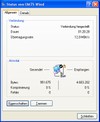Here I am in Boston and thanks to no data roaming agreements and use of different frequencies for UMTS my 3G mobile phones are pretty much useless. Well, pretty much but not quite as my N93 has Wifi on board which works over here just as well as back in the old world. So before I started my recent trip to Boston I was not quite sure how well free and municipal Wifi would keep me connected. After having been here for a couple of days, here’s what I experienced:
Free Hotel Wifi
Before coming over I searched the net if there are any hotels which have wireless Internet access included in the room price. While you would not find such a thing in Europe, there are actually a number of chains in the US that do this. A quick search came up with BestWestern and DaysInn hotels. It’s important to check that Wifi is available in all rooms or at least in the room you reserve. Otherwise, "Wifi available" could also mean that you can only surf in the lobby. I decided to stay in a DaysInn hotel as the room rates are around 75 dollars a night including Wifi. I double checked availability by calling the hotel before making the reservation and was not disappointed. The Wifi signal in the room was strong and the bandwidth with about 400 – 600 kbit/s good enough for VoIP, web surfing, business and of course, blogging.
Wifi on the Go

I like to check my eMail and my favourite news web sites every now and then while I am on the move so the next crucial thing was whether there were enough open Wifi hotspots along my path to keep me connected. I toured Salem, Portsmouth and Boston and was never disappointed. Many coffee shops along the route offered free Wifi. Salem was the most noteworthy city with free Wifi almost at every corner. This might be due to the SalemOpen.Net initiative started back in 2004. Well, it paid out to get me as a customer as the local coffee shops sold more to me than if there had been no Wifi around. I also noticed that many restaurants and coffee shops offer free Wifi without advertising it at the door. Some of them seem to do it intentionally as their Wifi network name (SSID) is usually the name of their business. Others just seem to have put a Wifi access point in place without doing anything and I encountered "linksys" access points more than once. Well, thanks for the ride.
While small businesses seem to have caught the idea of offering Wifi to their customers as an incentive to come and stay, bigger businesses like for example "Borders Books" only offered paid Wifi. Well, looks like they don’t need the moving elite to buy books from them. Also, I found directories of establishments offering free Wifi like this one a good thing to get a first idea of what’s available where you go but it’s impractical to plan your trip around the locations that are listed.
Summary
All in all I am quite happy to see that the idea of open and free Wifi for customers has taken hold in the U.S. (or at least here in Massachusetts) and much more so than in Europe where this phenomena is not yet wide spread. Also searching for free Internet access before sitting down somewhere is a charm with a Wifi enabled phone or PDA. If I lived here, however, I’d still take a service contract from one of the wireless operators, as hunting for a hot spot is definitely not something I would like to make a habit out of.


